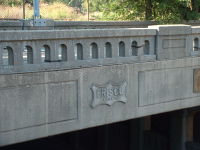Contents
Oklahoma City Union Depot is a building in Oklahoma City, Oklahoma that served as a "union station" from 1931 until 1967. It was listed on the National Register of Historic Places in 1979.[2] It now houses the offices of the Scissortail Park Foundation.
History


Oklahoma City Union Station was built as part of a plan to move surface rail lines and passenger stations of the Rock Island and Frisco railroads out of downtown Oklahoma City. Grade-separating the tracks of the Santa Fe was also part of the plan. Bonds were issued by the city government to repurchase the rights of way of the Frisco and Rock Island and to pay for new civic buildings on the vacated land.
Prior to the construction of Union Station, the Rock Island had its depot on North Broadway between West 1st and West 2nd Streets. The Frisco had its passenger facilities a few blocks to the west between West Main and West 1st Streets fronting on North Hudson Street.
The previous stations were last used on November 30, 1930, with passenger traffic being moved to a temporary station at the foot of South Hudson Street[1] the next day. The Santa Fe Depot remained in use, and the Missouri-Kansas-Texas Railroad also continued using its own station.
The depot closed to the public in 1967 following the discontinuance of the last passenger trains serving Oklahoma City. Frisco passenger train service ended in May 1967 and Rock Island passenger train service ended in November 1967.
Architecture and station facilities
The terminal building, with 55,000 sq ft (5,100 m2) on its main floor, is a sprawling, generous California Spanish Mission Revival style. Racial segregation was incorporated into the design of the building and thus, there are two waiting rooms, the larger of which was for white people only and the other for colored people. The structure included many elegant touches (small courtyards and alcoves with fountains and gardens surrounding the station building).
Passengers accessed the original 12-track station through tunnels via a ramp from the depot's waiting room. Mail and express shipments were also routed under the station to the surface passenger platforms. Traffic on Hudson and Harvey streets met the trains "at grade," enabling passenger access and exchange of mail and express freight between trucks and trains. Traffic on Robinson and Walker streets used underpasses built as part of the station complex. Freight warehouses and material handling areas were located behind the passenger facilities.



Tenant railroads
Union Station was served by two different railroads.
- The Rock Island, whose east-west route from Memphis to Tucumcari hosted several passenger trains, including:[3]
- the Choctaw Rocket (Memphis - Amarillo) and unnamed local service (Memphis - Tucumcari)
- The Frisco railroad operated trains such as the Meteor (St. Louis - Springfield, Tulsa - Oklahoma City), the Firefly (Kansas City - Oklahoma City) and the Will Rogers (St. Louis - Springfield, Tulsa - Oklahoma City) all through Tulsa to the northeast.[4]
Other Frisco trains operated between Oklahoma City Quanah, Texas via Lawton.[5]
These lines last saw passenger service in the 1960s with many sections saved from abandonment by the Oklahoma Department of Transportation and operated by short-line railroads.
Controversy
In the 1980s the facility was purchased by the city of Oklahoma City to become a multimodal transportation center at a cost of $1.8 million, with $1.2 million being a grant from the Federal Transit Administration. As part the I-40 Crosstown Realignment, the former yard tracks were replaced by the new highway. Space for two rail tracks in the station has been preserved as has the depot itself.
This realignment was unsuccessfully challenged by several organizations (OnTrac, North American Transportation Institute, Common Cause). This realignment will add an additional 10 lanes of road through downtown Oklahoma City while the current corridor becomes an at-grade boulevard.
On 6/5/2008 the Surface Transportation Board stated that BNSF Railway falsified an application and ruled against the realignment.[6] BNSF filed a petition to bypass hearings and debate all together to force the realignment [7][8]
References
- ^ a b Loudenback, Douglas (27 August 2007). "Doug Dawgz Blog: Okc Trains Part 2". Retrieved 15 July 2010.
- ^ a b "National Register Information System". National Register of Historic Places. National Park Service. March 13, 2009.
- ^ Official Guide of the Railways December 1940, Rock Island section, Table 41
- ^ Official Guide of the Railways December 1940, Rock Island section, Tables 1, 8
- ^ Official Guide of the Railways December 1940, Rock Island section, Table 10
- ^ "SURFACE TRANSPORTATION BOARD DECISION DOCUMENT - BNSF RAILWAY COMPANY--ABANDONMENT EXEMPTION--IN OKLAHOMA COUNTY, OK". Surface Transportation Board. 3 June 2008. Retrieved 15 July 2010.
- ^ "SURFACE TRANSPORTATION BOARD FILING DOCUMENT - Bnsf Railway Company--Petition for Declaratory Order". Surface Transportation Board. 14 July 2008. Retrieved 15 July 2010.
- ^ "SURFACE TRANSPORTATION BOARD FILING DOCUMENT - BNSF RAILWAY COMPANY--ABANDONMENT EXEMPTION--IN OKLAHOMA COUNTY, OK". Surface Transportation Board. 9 April 2008. Retrieved 15 July 2010.

